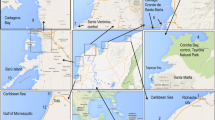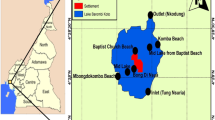Abstract
The purpose of this study is to assess metal concentrations and their bioavailability, and relate them to concentrations in fish tissues (gill, muscle and skin) as part of the ecotoxicological and public health assessment of the St Lucia system. Eight metals from six sites (Co, Cr, Cu, Fe, Mn, Ni, Pb and Zn) and five metals (Cu, Fe, Mn, Pb and Zn) from 60 fish, Oreochromis mossambicus, were analysed. Dissolved metal concentrations were highest in the north lake and lowest at the estuary. Sediment metal concentrations were highest in the north lake and lowest in the south lake. Most sediment metals displayed minimal to no anthropogenic enrichment. Normalisation with Fe showed all linear regressions as significant (p < 0.01) and Cr, Cu, Mn, Ni and Zn had R2 values well above 0.9. Only sediment Ni values were above the ERM. Tissue Cu, Fe and Pb concentrations were highest in the gills and Mn and Zn concentrations were highest in the skin. Skin Mn concentrations were highest as compared to the gills and muscle for all sites. The spatial differences in metal concentrations and BCF values for St Lucia suggest distinct populations of fish in the different areas of St Lucia. All concentrations of metals in fish tissues were below the permissible values indicating low human health threat. While higher sediment concentrations justified the economic benefit of mining, evidence of natural enrichment emphasised the need for continual conservation of the greater St Lucia area.






Similar content being viewed by others
Data availability
All data generated or analysed during this study are included in this published article.
References
Adams, J. B., Taljard, S., van Niekerk, L., & Lemley, D. A. (2020). Nutrient enrichment as a threat to the ecological resilience and health of South African microtidal estuaries. African Journal of Aquatic Science, 45(1–2), 23–40. https://doi.org/10.2989/16085914.2019.1677212
Buah-Kwofie, A., & Humphries, M. S. (2017). The distribution of organochlorine pesticides in sediments from iSimangaliso Wetland Park: Ecological risks and implications for conservation in a biodiversity hotspot. Environmental Pollution, 229, 715–723.
Cardoso-Silva, S., De Lima Ferreira, P. A., Moschini-Carlos, V., et al. (2016). Temporal and spatial accumulation of heavy metals in the sediments at Paiva Castro Reservoir (Sao Paulo, Brazil). Environmental Earth Sciences, 75, 9.
Chabukdhara, M., & Nema, A. K. (2012). Assessment of heavy metal contamination in Hindon River sediments: a chemometric and geochemical approach. Chemosphere, 87(8), 945–953.
Corsi, I., Mariottini, M., Sensini, C., Lancini, L., & Focardis, S. (2003). Fish as bioindicators of brackish ecosystem health: Integrating biomarker responses and target pollutant concentrations. Oceanologica Acta, 26(1), 129–138.
Day, J.H. (1981). Summaries of current knowledge of 43 estuaries in southern Africa. in J.H. Day (Ed.), Estuarine ecology with particular reference to Southern Africa (pp. 251–330). Rotterdam: A. A. Balkemia.
Dhaneesh, K. V., Gopi, M., Noushad, K. M., Ganeshamurthy, R., Kumar, T. T. A., & Balasubramanian, T. (2011). Determination of metal levels in thirteen fish species from Lakshadweep Sea. Bulletin of Environmental Contamination and Toxicology., 88, 69–73. https://doi.org/10.1007/s00128-011-0459-9
Di Toro, D., Allen, H. E., Bergman, H. L., Meyer, J. S., Paquin, P. R., & Santore, R. V. (2001). Biotic ligand model of the acute toxicity of metals. Environmental Toxicology and Chemistry, 20, 2383–2396.
Du Laing, G., Rinklebe, J., Vandecasteele, B., Meers, E., & Tack, F. M. G. (2008). Trace metal behaviour in estuarine and riverine floodplain soils and sediments: A review. Science of the Total Environment, 407, 3922–3985. https://doi.org/10.1016/j.scitotenv.2008.07.025
Hatje, V., Payne, T. E., Hill, D. M., McOrist, G., Birch, G. F., & Szymczak, R. (2003). Kinetics of trace metals uptake and release by particles in estuarine waters: Effects of pH, salinity and particle loading. Environmental International, 29(5), 619–629.
Herut, B., & Sandler, A. (2006). Normalization method for pollutants in marine sediments: Review and recommendations for the Mediterranean IORL Report H18/2006 Submitted to UNEP/MAP, pp. 23.
Hou, D., He, J., Lu, C., Ren, L., Fan, Q., Wang, J., & Zie, Z. (2013). Distribution characteristics and potential ecological risk assessment of heavy metals (Cu, Pb, Zn, Cd) in water and sediments from Lake Dalinouer. China. Ecotoxicology and Environmental Safety., 93, 135–144.
Humphries, M. S., Green, A. N., & Finch, J. M. (2016). Evidence of EL Niño driven desiccation cycles in a shallow estuarine lake: The evolution and fate of Africa’s largest estuarine system, Lake St Lucia. Global and Planetary Change, 147, 97–105.
Izegaegbe, J. I., Vivier, L., & Mzimela, H. M. M. (2020). Trace metal contamination in sediment in Mhlathuze Estuary, northern KwaZulu-Natal, South Africa. Effects on the macrobenthic community. Environmental Monitoring and Assessment, 192, 401. https://doi.org/10.1007/s10661-020-08352-9
Izegaegbe, J. L. (2020). The macrobenthic community and ecotoxicological status of Mhlathuze Estuary and Richards Bay Harbour, PhD Thesis, University of Zululand. pp 179.
Kuklina, I., Kouba, A., Buřič, M., Horká, I, Ďuriš, Z., & Kozák, P. (2014). Accumulation of heavy metals in crayfish and fish from selected Czech reservoirs. BioMed Research International, 2014, Article ID 306103, pp. 9. https://doi.org/10.1155/2014/306103
Kuklina, I., Kouba, A., & Kozak, P. (2013). Real-time monitoring of water quality using fish and crayfish as bioindicators: a review. Environmental Monitoring Assessment, 185, 5043–5053.
Landis, W. G., & Yu, M. H. (1995). Introduction to environmental toxicology: Impacts upon ecological systems. Florida: Lewis Publishers.
Lawrie, R. A., & Stretch, D. D. (2011). Anthropogenic impacts on the water & salt budgets of st Lucia estuarine lake in South Africa. Estuarine, Coastal and Shelf Science, 93(1), 58–67.
Li, H., Lin, L., Ye, S., Li, H., & Fan, J. (2017). Assessment of nutrient and heavy metal contamination in the sea water and sediment of Yalujiang Estuary. Marine Pollution Bulletin, 117(1–2), 499–506.
Liu, G., Tao, L., Liu, X., Hou, J., Wang, A., & Li, R. (2013). Heavy metal speciation and pollution of agricultural soils along Jishui River in non-ferrous metal area in Jiangxi province, China. Journal of Geochemical Exploration, 132, 156–163.
Long, E. R., & Mc Donald, D. D. (2010). Recommended uses of empirically derived, sediment quality guidelines for marine and estuarine ecosystems. Human and Ecological Risk Assessment: An International Journal, 4, 1019–1039.
Miller, P. A., Munkittrick, K. R., & Dixon, D. G. (1992). Relationship between concentrations of copper and zinc in water, sediment, benthic invertebrates, and tissues of white sucker (Catastomus commersoni) at metal-contaminated sites. Canadian Journal of Fisheries and Aquatic Sciences, 49, 978–985.
Muir, D.G., & Perissinoto, R. (2011). Persistent phytoplankton bloom in Lake St. Lucia (iSimangaliso Wetland Park, South Africa) caused by a cyanobacterium closely associated with the genus Cyanothece (Synechococcaceae, Chroococcales). Applied and Environmental Microbiology, 77(17), 5888–5896.
Mzimela, H. M., Wepener, V., & Cyrus, D. P. (2014). Spatial and temporal variations in selected heavy metals in water and sediment from the Mhlathuze Estuary, Richards Bay. African Journal of Environmental Science and Technology, 8(11), 670–683.
Nelke, E., Mulak, M., Łuczak, K., Pawlak, W., Nienartowitz, J., Szumny, D., Kochman, N., & Gerber, H. (2020). Occurrence and exposure to lead and cadmium and their environmental influence on eyesight. Polish Journal of Environmental Studies, 24(4), 1491–1496. https://doi.org/10.15244/pjoes/39551
Newman, B. K., & Watling, R. J. (2007). Definition of baseline metal concentrations for assessing metal enrichment of sediment from the south-eastern Cape coastline of South Africa. Water Sa, 33(5).
O’Brien, A., Townsend, K., Hale, R., Sharley, D., & Pettigrove, V. (2016). How is ecosystem health defined and measured? A critical review of freshwater and estuarine studies. Ecological Indicators, 69, 722–729.
Paquin, P., Di Toro, D., Santore, R., Trivedi, D., & Wu, K. (1999). A biotic ligand model of the acute toxicity of metals. III. Application to fish and daphnia exposure to silver. In US EPA (Ed.), Integrated approach to assessing the bioavailability and toxicity of metals in surface waters and sediments. EPA-822-E-99–001. Washington, DC, pp 3–59–3–102.
Playle, R., Gensemer, R., & Dixon, D. (1992). Copper accumulation on gills of fathead minnows—Influence of water hardness, complexation, and pH of the gill micro-environment. Environmental Toxicology and Chemistry, 11, 381–391.
Porter, S. N., Branch, G. M., & Sink, K. J. (2013). Biogeographic patterns on shallow subtidal reefs in the western Indian Ocean. Marine Biology, 160, 1271–1283.
Rajkowska, M., & Protasowicki, M. (2013). Distribution of metals (Fe, Mn, Zn, Cu) in fish tissues in two lakes of different trophy in Northwestern Poland. Environmental Monitoring and Assessment, 185, 3493–3502. https://doi.org/10.1007/s10661-012-2805-8
Riba, I., Garcia-Luque, E., Blasco, J., & DelValls, T. A. (2003). Bioavailability of heavy metals bound to estuarine sediments as a function of pH and salinity values. Chemical Speciation and Bioavailability, 15(4), 101–114.
Taylor, R., Fox, C., & Mfeka, S. (2013). Monitoring the St Lucia Estuarine System: A synthesis and interpretation of the monitoring data for March–April 2013. Unpublished Ezemvelo KZN Wildlife report. pp.19.
Vermeulen, L. A., & Wepener, V. (1999). Spatial and temporal variations of metals in Richards Bay Harbour (RBH), South Africa. Marine Pollution bulletin, 39(1–12), 304–307.
Vilmi, A., Karjalainen, S. M., Nokela, T., Tolonen, K., & Hario, J. (2016). Unravelling the drivers of aquatic communities using disparate organismal groups and different taxonomic levels. Ecological Indicators, 60, 108–118.
Weber, P., Everton, R. B., Camila De Lellis, K., Daniel, S. V., Erico, M. F., Valderi, L. D., & Bernardo, B. (2013). Metals in the water, sediment and tissues of two fish species from different trophic levels in a subtropical Brazilian river. Microchemical Journal, 106, 61–66.
Williams, G. E., & Steenkamp, J. D. (2006). Heavy mineral processing at Richards Bay minerals. Southern African Pyrometallurgy, 191–188.
Zhang, C., Yu, Z., Zeng, G., Jiang, M., Yang, Z., Cui, F., Zhu, M., Shen, L., & Wu, L. (2014). Effects of sediment geochemical properties on heavy metal bioavailability. Environmental International, 73, 270–281.
Zikhali, Z., Tirok, K., & Stretch, D. (2015). Sediment resuspension in a shallow lake with muddy substrates: St Lucia, South Africa. Continental Shelf Research, 108, 112–120.
Zwolsman, J. J. G., & van Eck, G. T. M. (1999). Geochemistry of major elements and trace metals in suspended matter of the Scheldt estuary, Southwest Netherland. Marine Chemistry, 66, 91–111.
Acknowledgements
The authors would like to thank Prof L. Vivier and Mr Q. Schutte for help with sampling. Assistance from the staff of the Department of Zoology, University of Zululand, during preparation of samples and analyses is highly appreciated.
Funding
This study was funded by the Department of Zoology, University of Zululand.
Author information
Authors and Affiliations
Ethics declarations
Conflict of interest
The authors declare no competing interests.
Additional information
Publisher's Note
Springer Nature remains neutral with regard to jurisdictional claims in published maps and institutional affiliations.
Rights and permissions
About this article
Cite this article
Mzimela, H.M.M., Izegaegbe, J.I. Metal behaviour in water, sediment and fish from the St Lucia system: implications for public health and ecosystem impact. Environ Monit Assess 193, 807 (2021). https://doi.org/10.1007/s10661-021-09602-0
Received:
Accepted:
Published:
DOI: https://doi.org/10.1007/s10661-021-09602-0




